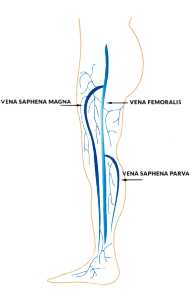 When our venous valves are working effectively, every muscle movement of the leg causes blood to be pumped inward and upward past a series of cups. In motion, the normal pressure in the venous system of the lower leg is nearly zero. Immediately after ambulation, the early standing pressure in the normal leg remains low. Arterial inflow fills the leg veins slowly, and the only source of venous pressure is the hydrostatic pressure of a column of blood as high as the nearest competent valve. After prolonged standing, the veins are completely filled, and all the venous valves float open. At this time, high hydrostatic venous pressure results from the unbroken column of fluid that extends from the head to the foot.
When our venous valves are working effectively, every muscle movement of the leg causes blood to be pumped inward and upward past a series of cups. In motion, the normal pressure in the venous system of the lower leg is nearly zero. Immediately after ambulation, the early standing pressure in the normal leg remains low. Arterial inflow fills the leg veins slowly, and the only source of venous pressure is the hydrostatic pressure of a column of blood as high as the nearest competent valve. After prolonged standing, the veins are completely filled, and all the venous valves float open. At this time, high hydrostatic venous pressure results from the unbroken column of fluid that extends from the head to the foot.
Failed valves cause the column of standing blood in the vein to remain high even when during ambulation. The hydrostatic pressure increased during and immediately after ambulation.
High venous pressure is directly responsible for many aspects of venous insufficiency syndrome, including oedema, tissue protein deposition, perivascular fibrin cuffing, red cell extravasation, impaired arterial inflow, and other locally mediated disturbances.
Not all of the complications of venous insufficiency are related to venous hypertension, and not all patients with venous hypertension develop ulceration. Some patients with venous ulceration do not have marked venous hypertension.